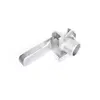Mobile:+86-311-808-126-83
Email:info@ydcastings.com
Techniques and Benefits of Centrifugal Casting for Aluminum Components in Manufacturing
The Advantages and Applications of Centrifugal Casting in Aluminum Production
Centrifugal casting is a highly efficient manufacturing process that has gained popularity in various industries, particularly for producing high-quality aluminum components. This method involves pouring molten aluminum into a rotating mold, utilizing centrifugal force to ensure uniform density and strength throughout the cast product. Over the years, centrifugal casting has proven to be advantageous due to its ability to produce exceptionally durable parts with minimal defects, making it a preferred choice for many applications.
The Centrifugal Casting Process
The centrifugal casting process begins with the preparation of the mold, which is typically made of metal or a durable material that can withstand high temperatures. The mold is then mounted on a rotating axis, and once it reaches a specific speed, molten aluminum is poured into the cavity. The centrifugal force generated by the rotation pushes the aluminum against the mold walls, allowing it to take shape while enhancing the density of the resulting product.
As the aluminum cools, it solidifies against the mold, forming a dense structure with a refined grain microstructure. This process creates components that are not only lightweight but also exhibit remarkable mechanical properties, such as improved tensile strength and wear resistance. Additionally, the solidification process in centrifugal casting minimizes the formation of voids and impurities, leading to high-quality finished products.
Key Advantages of Centrifugal Casting
1. High Material Density One of the primary benefits of centrifugal casting is the high density of the produced components. The centrifugal force compacts the molten aluminum, resulting in reduced porosity and a more uniform microstructure. This is especially important in applications where mechanical strength and durability are critical.
2. Reduced Defects Traditional casting methods often involve a range of defects, such as air pockets and inclusions. Centrifugal casting significantly reduces the likelihood of these imperfections due to the consistent flow of molten metal and the pressure applied during the process. This leads to higher yield rates and less waste.
centrifugal casting aluminum

3. Customizable Designs The centrifugal casting process allows for the production of complex shapes with tight tolerances. Manufacturers can create custom molds to achieve specific geometries, which is particularly beneficial in industries like automotive and aerospace where design flexibility is essential.
4. Cost-Effective Production Although the initial investment for equipment may be higher than other casting methods, the efficiency of centrifugal casting results in lower overall production costs. Reduced material waste and higher throughput rates contribute to a more favorable return on investment over time.
5. Versatility Centrifugal casting is suitable for a variety of aluminum alloys, enabling manufacturers to tailor material properties to meet specific requirements. This versatility allows for applications in diverse fields, from manufacturing engine blocks and wheels to producing plumbing fittings and electrical components.
Applications of Centrifugal Cast Aluminum
Centrifugal cast aluminum is widely used across various industries due to its advantageous properties. In the automotive sector, it is employed for producing crankcases, cylinder heads, and transmission cases, where strength and heat resistance are paramount. In the aerospace industry, components such as wheel rims and landing gear parts benefit from the lightweight yet durable nature of centrifugal cast aluminum.
Moreover, industrial applications also see the use of centrifugal cast aluminum in manufacturing gears, bearings, and pump housings. The energy sector utilizes this method for turbine housings and other components that require increased durability under stress. In addition, the electrical manufacturing industry employs centrifugal casting for creating high-performance connectors and fittings due to the material's excellent conductivity.
Conclusion
Centrifugal casting remains a valuable technique in the production of aluminum components, combining efficiency with high-quality outputs. With its many advantages, including enhanced material density, reduced defects, and versatility, it is clear why this method is increasingly being adopted in various industrial applications. As technology continues to evolve, the potential for centrifugal casting to meet the demands of modern manufacturing will undoubtedly expand, further solidifying its position as a leading method for aluminum production.
-
Why Should You Invest in Superior Pump Castings for Your Equipment?NewsJun.09,2025
-
Unlock Performance Potential with Stainless Impellers and Aluminum End CapsNewsJun.09,2025
-
Revolutionize Your Machinery with Superior Cast Iron and Aluminum ComponentsNewsJun.09,2025
-
Revolutionize Fluid Dynamics with Premium Pump ComponentsNewsJun.09,2025
-
Optimizing Industrial Systems with Essential Valve ComponentsNewsJun.09,2025
-
Elevate Grid Efficiency with High-Precision Power CastingsNewsJun.09,2025











